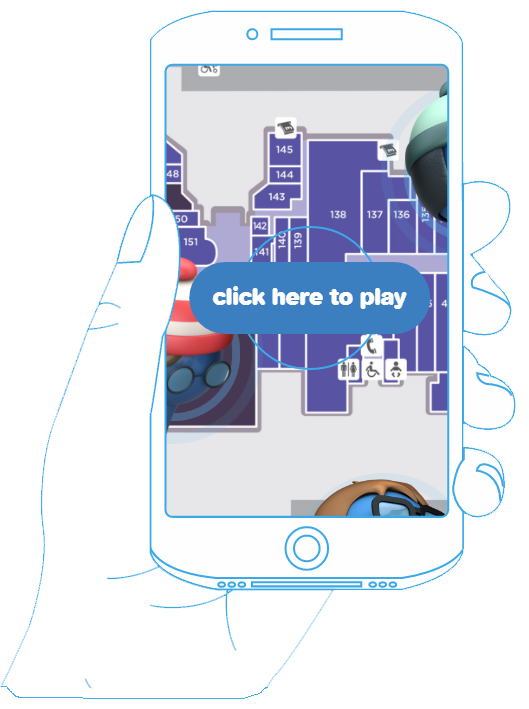By Marius Kurgonas – Mobile Developer at sensewhere
Shall we play a game? Several of your friends are wandering around a huge mall shopping around – your task is to quickly find all the stores they are in. You have 5mins and your time starts now.
Impossible? Too little time to search in too large a space?
Wrong. Indoor positioning technologies have the superpower to locate them. Fast. Nothing should stop you from playing whatever you want!
Importance of location in games
Over the last few years we have witnessed a huge success and growing popularity of location-based games such as Ingress (2012) or the recent boom of Pokemon:Go, which showed everyone how the social aspect of games combined with location can take gameplay to another level: exploring the real world.
Looking beyond GPS
All location-based games typically take advantage of GPS positioning, which has proven to be accurate enough in an outdoor environment with a precision of up to 3-4 meters. But because GPS signals depend on satellites, acquiring position information inside becomes much more challenging due to the signals not being able to penetrate walls or getting reflected off windows and other materials, ultimately becoming highly inaccurate and unreliable.
Wi-Fi trilateration – your mobile device can scan for all nearby Wireless Access Points (WAPs) and measure signal strengths between them to calculate an approximate location. The Android platform has a public API for Wi-Fi scans and exposes it to developers so they can build apps based on this principle, sensewhere’s Android SDK maps the location of any Wi-Fi signal very accurately. Unfortunately, Apple does not allow this, so iOS developers have to look into other location sources instead.
BLE trilateration – this solution involves scanning for Bluetooth Low Energy (BLE) enabled devices and estimating the position using signal strengths. Because many electronic devices as well as all the new smartphones these days have Bluetooth built in, there is an opportunity to take advantage of this in large environments like shopping malls, airports or other venues. This approach poses some limitations but for the most part acquiring position is possible on Android as well as iOS.
Dedicated beacons – beacons are being strategically installed by 3rd party companies in targeted locations with the coordinates known beforehand, creating opportunities for much more precise positioning. sensewhere Android SDK can automatically map these BLE beacons creating a database of their known location. Consequently, scanning devices around for those known beacons makes the positioning approach much more reliable than relative trilateration.
Challenges
As pointed out, indoor gaming can take advantage of several positioning strategies without the reliance on GPS. However, the problem with those approaches is that they all require some level of manual setup to work. So, if mobile games were to take advantage of indoor positioning – each venue would require a manual setup before players could even think about catching Pokémons. Otherwise the data would be hugely inaccurate and defeat the purpose of the game.
Our approach
Here is where sensewhere technology comes into play. Our cloud-based unified indoor positioning solution takes advantage of all the methods mentioned above and enables scaling through automatic crowdsourcing. sensewhere’s mobile SDK automatically maps the location of both Wi-Fi and BLE beacons, this process generates an independent location database that provides very accurate indoor positioning. Not only do you get a plug-in mobile SDK solution for Android and iOS, but also dedicated client server installations as needed and capability to extend into any indoor space in the world.
Example: Hide and Seek
This is an example of how simple it is to implement the basic concept of Hide and Seek using sensewhere’s positioning technology.
-> The task here is to find which shops each of your friends are in, under time pressure. <-
There are several individuals shopping in different stores of a huge multi-floor mall. The player is given a smartphone with the sensewhere-powered game to try and find their friends quickly. A pattern of “hot” or “cold” images accompanied by sound effects emerges strategically throughout the experience, until the player locates all the shops in which the shoppers in question are present.
App setup – the game setup is very simple. On top of the world map shown in the application, individual map layers emerge upon zooming, showing detail of indoor spaces for all the shops. Once the game starts, the user is pointed in the direction of their friends with a series of flashing “hot” or “cold” images and sounds beeping while navigating through the mall. The closer the user gets to each friend the more often the hot image flashes and the more constant the sound becomes until the friend is located.
Mobile SDK – our mobile SDK comes as a plug-in framework on both Android and iOS, platform; we replaced native location calls with calls to our SDK and take advantage of the unified cloud solution.
Results – in our trial runs we mapped the beacons first using crowdsourcing and applied the trilateration to obtain positioning. The user managed to get as close as a few meters to each friend, able to then easily find them in a shop.
Given the current technology and the rapid advancements it seems that the increasingly accurate positioning inside buildings will have a profound effect on the expansion of our digital worlds.
Here are just a few ideas but sky is the limit:
Existing games could expand their capabilities – big games like Pokemon:Go, Ingress, CodeRunner etc. that have spread around the globe can take advantage of indoor navigation by extending the game inside of shopping malls, airports or schools. Our technology is a perfect match for these use cases.
Dedicated games – venue owners can have their own games with a dedicated setup for nightly competitions like escape rooms.
Augmented reality – with its growing popularity outdoors, using the right tools for augmented reality the indoor world can become richer, too.
sensewhere continues to drive indoor games forward providing state of the art indoor positioning that augment the Google and Apple location platforms. It’s so scalable that it can be plugged into any game for an added layer of experience. To find out how our technology can make your game better, drop us a line: info@sensewhere.com.



























